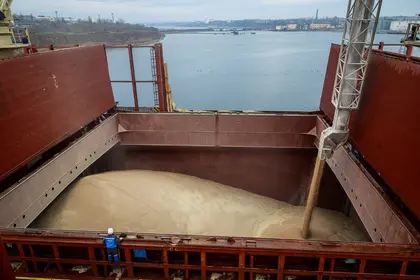On July 17, 2023, five days short of the Black Sea Grain Initiative’s one-year anniversary, the Russian Federation withdrew from the wartime agreement aimed at transporting Ukrainian grain through the weaponized Black Sea to the world market. The withdrawal restores the regime of temporary danger in the area, with Russia saying that any vessels going to or coming from Ukrainian ports would be considered potential military targets.
The future of the Grain Initiative for now is unclear. Russia wants the West to lift the sanctions and reconnect its banks to the SWIFT system as one of the prerequisites for any potential Grain Deal renewal. Yet no negotiations are being held at the moment and Ukraine is looking for ways to export the grain under the time pressure of the new harvest.
Wartime Ukrainian export landscape: pre-Grain Initiative
Since the very start of the full-scale Russian invasion of Ukraine in February 2022, the Ukrainian agricultural sector, which provided for 10 percent of the country’s GDP pre-war, immediately felt a major blow. Two days into the invasion, Russian forces blockaded the Black Sea, suspending the sea exports that accounted for 95 percent of all Ukraine’s grain export capacity. This trapped about 20 million tons of grain in the country prior to a new harvest.
Moreover, Russian missiles were targeting agricultural land, farm infrastructure and equipment, storage facilities, and export infrastructure, while the Russian army was either stealing tons of grain, selling it as their own, or burning it.

Tsikhanouskaya Honors Ukraine’s Day of Dignity and Freedom
Without the sea, Ukraine could export only 500,000 tons monthly, thus the exporters had no other choice but to look for alternative routes – the “overland” route by trucks and trains to Europe, and the “sea” option through the Danube River to Black Sea ports of Romania.
Major investments have been made to develop both of these options. The “overland” route was mostly developed with the EU-Ukraine Solidarity Lanes initiative. It focused on mobilizing additional rolling stocks, vessels, and trucks; improving the capacity of transport networks and transshipment terminals; speeding up customs operations and other inspections; working on storage of goods on the EU territory; and repairing existing infrastructure. All of this work made it possible to export about 4 million tons of grain and oilseeds monthly, accounting for 60 percent of Ukrainian wartime export.
Yet due to the lower price and proximity, most traffic flows have been reoriented to the Danube region’s seaports, with three regular container services launched. In 2022, investments in Ukrainian Danube ports reached $15 million. The Ukrainian Sea Ports Authority prepared infrastructure in Izmail and Reni, facilitating container transshipment and additional port capacities. Private investors contributed to the launch of several marine terminals. Overall, the exporting capacity increased from 5.5 million tons in 2021, to 16.5 million tons in 2022, and was expected to reach 23 million tons in 2023.
Wartime Ukrainian export landscape: Grain Initiative
Everyone knew that the alternative routes would not be able to replace Ukrainian Black Sea ports entirely, as they were administering 7 million tons of grain and oilseeds pre-war, the volume yet to be reached with alternative routes. Moreover, exporting by sea from Ukrainian ports is half as expensive as exporting with delivery to European ports.
Above all the Grain Corridor ensured that the Russian Federation would not target ships. This gave Ukrainian farmers confidence that they could export their produce and sow more. In total, the Initiative helped to export around 30 million tons of grain and related products during almost a year of its existence. The main export markets for the grain were Algeria, Morocco, Egypt, Nigeria, and Pakistan.
Nevertheless, the Grain Corridor was successful only in the first three months of its existence and later lost interest from exporters due to long downtime and Russian shelling. From August to October 2022, 421 ships used it, exporting 9.7 million tons of wheat, corn, sunflower, and oil. Inspection teams, including representatives from Ukraine, the UN, Turkey, and Russia, allowed an average of five to six ships through per day. In October 176 vessels used the corridor, while in November, 85, and in June 2023, only 37 vessels used it. Ukraine exported 4 million tons of products by sea in March, but only 1.3 million tons in May, less than a third of the potential volume.
Moreover, exporters were losing approximately $20,000 daily for waiting for the inspection in the ports, which led only to increasing prices and, simultaneously, decreased revenues. As such, there are now doubts about whether to even make an effort to restore the Grain Corridor in the form it was operating during the last six months.
Future of the Grain Initiative and Ukrainian export
In the upcoming weeks, we will see what Ukraine and international partners have come up with regarding the Grain Corridor. Yet although the Corridor looks too expensive to use, it preserved the desire of Ukrainian farmers to sow. Without the Initiative, the sown area could decrease by 25 to 30 percent. It would still be enough to provide Ukraine with the needed produce, but globally it would increase the price of grain, leading to food inflation in the developed countries and hunger in the developing world, which would not be able to afford to buy grain.
Following the failure of the Black Sea grain agreement, an EU official recommended that member states fund the higher costs of transporting Ukrainian grain by land. The EU is preparing to facilitate the export of all of Ukraine’s grain via the bloc’s solidarity lanes; yet at the Aspen Security Forum, US Secretary of State Antony Blinken stated that expanding the use of land routes would not make up for the volume of goods lost after Russia withdrew from the Black Sea grain deal.
Nevertheless, now the main talks revolve around the expanding volume of the already existing routes and the development of new alternative routes. The latter include:
● The Baltic Sea. Lithuanian officials stated that the Baltic States officially asked the European Commission for help with increasing the railway capacity for the Baltic route port. This route will allow exporting 25 million tons annually, yet the logistics price will be much higher;
● The Adriatic Sea. Croatia offered its rail network and ports on the Adriatic Sea as an alternative route for Ukrainian grain. The potential export volumes are not specified, according to Minister of Agrarian Policy and Food of Ukraine Mykola Solsky, it will be some hundreds of thousands of tons, while Ukraine needs millions monthly. Yet the cereal terminal in the Rijeka basin has a storage capacity of 800,000 tons per year and a one-time storage capacity for about 56,000 tons of cereals.
● The Mediterranean Sea. Bulgaria and Greece proposed to use Bulgarian trains at the Ukraine-Romania border and transport the grain through Bulgaria to Greece. The potential volume is as yet unknown, and it is unclear which of the Bulgarian carriers will be able to transport this cargo due to the state rail carrier’s shortage of locomotives and wagons.
● Overland Western border. Lastly, without the use of ports, Ukraine and international partners could focus on building additional border checkpoints for exports in the Volyn, Lviv, and Zakarpattia regions.
Overall, if the Black Sea Grain Initiative is not renewed, the efforts will go into improving the existing routes and developing the new ones. If it is renewed, the Russian Federation will remain an unreliable partner, therefore, the alternative routes still will be developed but at a slower pace. Completely reorienting grain export to rail and road will prove dangerous to the Ukrainian economy, since grain will displace other commodities that were previously transported largely by rail.
At the moment, the partners are not considering options of having warships escort cargo ships nor of providing air support for the ships operating in the Black Sea. Meanwhile, Russia continues to attack port infrastructure, including the facilities on the Danube River, which inflates grain prices.
Recommendations
To maintain food security in the world, Ukraine now needs significant investment in the enlargement of export volumes and the construction of new routes. The Danube direction needs the organization of raid transshipment, ensuring the round-the-clock operation of the Sulin Canal in Romania, and improvement of the Ukrainian Bystre river mouth. The overland direction needs to expand the logistics of land deliveries of Ukrainian agricultural products through the EU. That includes partnering with international financial institutions to increase capacity, increase repairs, and liquidity for operators on the market.
The views expressed in this opinion article are those of the authors and not necessarily of Kyiv Post.
You can also highlight the text and press Ctrl + Enter






